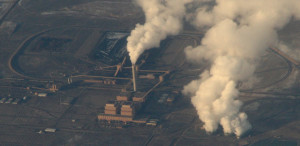
Intermountain Power Project coal-fired plant, Utah
The death of Republican U.S. Supreme Court Justice Antonin Scalia has refocused attention on how much is at stake in the 2016 presidential election. We have an ongoing series on this subject, including the president’s power to nominate Supreme Court justices and other federal court judges. Another area of great importance and great difference between the parties which is at stake in November is the future of our environment, including fighting climate change.
The ability of the Executive Branch to do something — or nothing — on the environment is vast. In 1970, Republican President Richard Nixon created the Environmental Protection Agency (EPA). Two years later, however, Nixon vetoed the Clean Water Act (officially, the Federal Water Pollution Control Act Amendments of 1972). Congress overrode Nixon’s veto, with plenty of Republican votes. Since then, however, Democratic and Republican presidents have diverged even more in their attitudes toward protecting the environment.
When Ronald Reagan became president in 1981, he brought with him an anti-government philosophy and an anti-environmental team. Reagan’s Interior Secretary, James Watt, hailed from the right wing Mountain States Legal Foundation, a pro-business, anti-environmental public interest law firm. Under Reagan, Watt helped open up massive tracts of federal land to coal mining at fire sale prices, and large stretches of the Continental Outer Shelf to oil drilling.
Reagan’s EPA Administrator Anne Gorsuch a/k/a Anne Burford, was another anti-government acolyte who cut EPA’s budget by 22 percent and cut its regulations accordingly. Eventually, Gorsuch had to resign after becoming enmeshed in the EPA’s Superfund mismanagement scandal.
Under President George W. Bush, Gale Norton, an oil and metals industry lobbyist who was a protege of James Watt at the Mountain States Legal Foundation, became Interior Secretary. Norton tried to implement anti-government, pro-business, so-called “Wise Use” principles “through regulatory rollbacks, suppression of science, preferential treatment, and collusion with industry.” Eventually, Norton resigned as her department became embroiled in the Jack Abramoff scandal.
Bush’s EPA didn’t fare much better. Just after the attacks of September 11, 2001, under instructions from the Bush White House, EPA Administrator Christie Todd Whitman falsely told first responders and nearby residents that the air at the World Trade Center was safe to breathe. Eventually, Whitman resigned, later writing that she could no longer abide the pro-industry, anti-regulatory climate in the Bush/Cheney White House.
The environmental record has been a bit different under recent Democratic administrations. President Bill Clinton and his EPA Administrator Carol Browner took action on mercury pollution, protected lands with national monument designations, strengthened drinking water protections and toughened clean air standards. Vice President Al Gore was perhaps the first high-profile person to get Americans to notice the dangers of global warming and climate change, and has dedicated his life to this cause ever since.
More recently, President Barack Obama has dedicated huge amounts of land and water as national monuments, protecting them from new development. Obama also forged an historic agreement with China to reduce greenhouse gases which cause climate change, and helped get 195 countries to take action on climate change at the COP 21 summit in Paris in December 2015. The Obama EPA also passed an ambitious Clean Power Plan in 2015, which requires power plants to cut pollution levels. On February 9, 2016, the U.S. Supreme Court, in a 5-4 decision, issued a stay of the new EPA rules while lower court challenges take place. However, with the death of Justice Scalia four days later, the fate of the Obama Clean Power Plan may have improved. The resulting fight over nominating a replacement for Scalia again highlights the importance of presidential elections, and there are potentially several more Supreme Court openings in the next few years. As for the Republicans and their presidential candidates? Most of them are climate change deniers to one degree or another.
Today, America and the world continue to face numerous environmental challenges, from climate change to the Porter Ranch, California methane leak to horrendous air pollution in China, some of which drifts to the U.S. The next president may face many make-or-break moments for the future of our planet and our health. Whether that president is a Democrat or a Republican may make a huge difference as to what we might expect them to do in response.
Photo by Doc Searls, used under Creative Commons license. http://is.gd/kM1a4u


